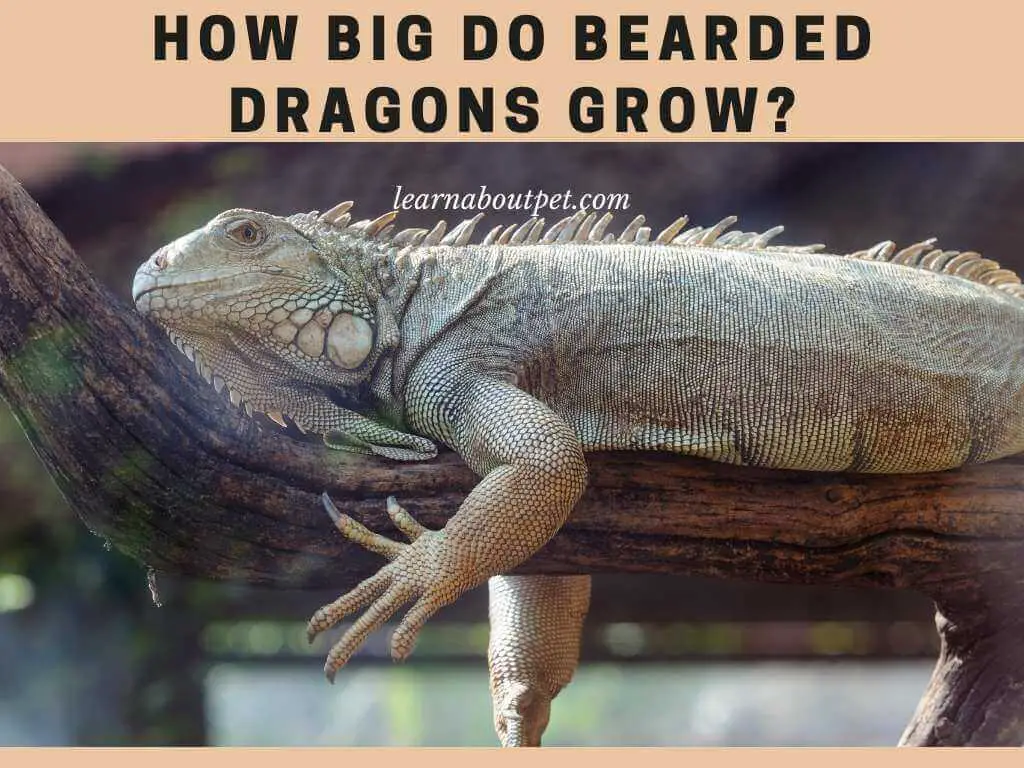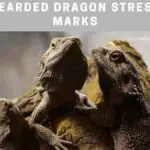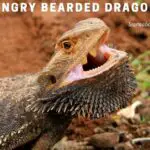Many people ask the question of how big do bearded dragons grow. It depends upon many factors like sex, breed, and gender of the bearded dragon. Some breeds have large size, and some breed has a small size, so the answer to this question depends on breed and sex of bearded dragons. A bearded dragon growth chart helps feed them appropriate to their size.
How big do bearded dragons grow? At the age of twelve months, when bearded dragons become adults, then they will fully grow. Adult bearded dragons have sixteen to twenty-four inches in size, and their weight ranges from 380-510g.
This article will discuss how big do bearded dragons grow, three different stages of a bearded dragon’s life, Bearded dragon size, and factors that affect the size of bearded dragons. Let’s dive into the details of bearded dragon size.

How Big Do Bearded Dragons Grow?
how big do bearded dragons grow? The bearded dragon size depends upon many factors. If a bearded dragon belongs to a large breed, they will grow large from the normal breed. If the breed has a small size, then it will grow in a small size. Gender also plays an important role in bearded dragon size.
how big do bearded dragons grow? A fully grown dragon has about sixteen to twenty-two inches when they are only one year old. the 2-month-old bearded dragon is about six to nine inches.
Bearded Dragon Size By Age
When a bearded dragon ages one year, they will get the maximum size. Bearded dragon size grows gradually, and it will be fully large when they reach two years. Here is a bearded dragon size chart that helps know the bearded dragon length.
| Age Of Bearded Dragon | Length Of Bearded Dragon |
| 1-month-old baby | 3 to 4 inches |
| 2-month-old baby | 5 to 9 inches |
| 3-month-old baby | 8 to 11 inches |
| 4-month-old baby | 9 to 12 inches |
| 5-month-old baby | 11 to 16 inches |
| 6-month-old juvenile | 11 to 18 inches |
| 8-month-old juvenile | 13 to 20 inches |
| 12-month-old Adult | 16 to 22 inches |
| 24-month-old Adult | 18 to 24 Inches |
How Big Do Bearded Dragons Grow In The Wild?
how big do bearded dragons grow? Bearded dragon growth rate depends upon many factors like gender, housing, and diet. The size of bearded dragons in the wild is the same, just like bearded pet dragons. They get a size of twenty-four inches. Bearded dragon full size is about twenty-four inches.
A full-grown bearded dragon female has sixteen to nineteen inches in length. Like other organisms, the male bearded dragon has a larger size as compared to female bearded dragons. If you take much care of the bearded dragon’s diet in time of development, then it can get the size of twenty-two to twenty-four inches.
How Big Do Bearded Dragons Grow In Captivity?
how big do bearded dragons grow? The average size of a bearded dragon is about eighteen to twenty-four inches. The female dragon can grow to twenty-two inches if you provide her balanced and nutritious diet in the developmental period. Male dragon may get the size of twenty-four inches in length.
How Big Do Bearded Dragons Grow In A Month?
how big do bearded dragons grow? When bearded dragons are born, they have very small sizes. At the age of one month, the only bearded dragon has about three to four inches in size, and with an increase in a month, they will grow properly.
It is estimated that bearded dragons get two inches of length in one month, but this growth is only at two years. After two years, they will not grow in size.
How Big Do Bearded Dragons Grow Without Tail?
When we talk about bearded dragon size, it means that size is not along with the tail. The length of the tail is the same as the length of the body. how big do bearded dragons grow? Normally, when the bearded dragon is fully grown, they have twenty-four inches, and it may vary according to breed and gender of bearded dragons.
How do Big Do Fancy Bearded Dragons get?
A fancy bearded dragon also gets the same size as a simple bearded dragon. how big do bearded dragons grow? The size of a bearded dragon depends upon the diet also.
When do bearded dragons stop growing? If you give a proper and balanced diet to dragons in the early age of development and growth, you will see significant changes in the length of bearded dragons. Central bearded dragon size is 24 inches. 1-year-old bearded dragon attains maximum size. After that, they will grow at a very slow rate.
How Long Does It Take For A Bearded Dragon To Grow To Full Size?
How big can a bearded dragon get? The full size of dragons depends upon many factors like health, diet, environment, sex, genetics, etc. if the baby of a bearded dragon is healthy, they can grow about one to three inches in one month.
They get full size at the age of twelve months. After that, they complete the rest of the growth in the next few years. At the age of two years, they will get the maximum length.
When Do Bearded Dragons Stop Growing
It depends upon the breed of bearded dragons how much time they take to grow to full size. How long does it take for a bearded dragon to grow? Many bearded dragons get maximum size at only the age of twelve months.
Many bearded dragons are also there that attain maximum length at the age of twenty-two months. It all depends upon the environment, breed, gender, and diet of bearded dragons.

What Size Tank Does A Full-Grown Bearded Dragon Need?
The size of the tank should be ideal. Its length should be four feet, and width should be two feet. Mature adults and young adults should have fifty-five to one hundred twenty-gallon enclosures. If there is a very large tank size, it is good for adult bearded dragons because they can move freely in large tanks.
How long does a bearded dragon grow? Bearded dragons will grow to full size on the first birthday, but many dragons also get a second birthday. The maximum growth will be in the first twelve months of the life of bearded dragons.
In the second year of life, they will only grow two to three inches in size. Growth is hard to observe because it is very slow. In the second year, a bearded dragon will gain more weight, reach average body weight, and become an adult.
What Are Factors That Affect The Size of Bearded Dragon’s
Bearded dragon full-grown size is about twenty-two inches. It depends upon gender also. Female bearded dragon size is small as compared to male dragons. If there is a big bearded dragon, then it can be due to genetic makeup. Here are the possible factors that affect the size of bearded dragons.
Genetics
A fully grown bearded dragon male is about twenty-four inches in size. Genetic makeup plays an essential role in the size of bearded dragons. If there is a large size in genetics, then the offspring will also have a large size.
Gender
How big do bearded dragons grow? Gender also affects the rate of growth, just like other organisms. The size of the female dragon is small as compared to the male dragon. Large bearded dragon has a size of 24 inches, and it is male. The size of a female is small because of many hormonal reasons. The size of the female dragon is between sixteen to nineteen inches. If you give a proper diet to female dragons in the growth period, they can get twenty to twenty-two inches.
Diet
Bearded dragon growth rate can be increased by giving a proper diet. Diet plays an important role in the growth of any organism. If you provide a balanced and nutritious diet to bearded dragons, then they get good size. It would be best if you did not use a low nutrient diet for dragons. Please don’t use the fat insects because there are no proper nutrients, and hence bearded dragons will not grow properly.
It would be best to change the diet of bearded dragons when they reach adulthood because there is a different diet for different ages of dragons.
- When they are juveniles, they need more proteins as compared to adult dragons. You should provide them seventy-five percent insects and twenty-five percent plants when they are juveniles.
- When they grow fully, they should eat seventy-five percent vegetables and twenty-five percent insects.
Housing
Habitat also affects the rate of growth. There should be a setup for bearded dragons in which they can freely move without any hindrance. If the size of the tank is small or improper, this will result in stunted growth of bearded dragons. It is because they do not have enough space to exercise and grow.
How big can bearded dragons get? When the bearded dragon is in the juvenile phase, you should arrange about forty-gallon tanks. When they become adults and fully grown, the tank should be 120 gallons. It would be best to give them proper lighting because it is a good source of vitamin D. You also give them calcium supplements.
The tank must be in complete darkness at night. It is because bearded dragons need darkness to sleep. When the bearded dragon has no proper sleep, then it will not grow properly. If they have no proper sleeping time, then they will also have small size.
Husbandry
Poor care and husbandry lack can be the reason for the small size of the bearded dragon. It can also result in low bearded dragon weight. When the bearded dragon is ill, they will not get enough nutrients, and there is growth retardation in them.
If you observe any signs like sluggish behavior, bloating, weight loss, and appetite change in bearded dragons, it means that they are ill. You should consult with your vet in this situation.
How Fast Can A Bearded Dragon Run?
The speed of running of bearded dragons is 9 miles in one hour. It means that they can cover nine miles of distance in only one hour.
What Are The Different Life Stages Of Bearded Dragons
There are three different stages of a bearded dragon’s life. The first one is the baby, the second phase is the juvenile, and after that, they become adults.
Hatchling/Baby
When bearded dragons are between the age of birth and size months, then it means that they are babies. This is a period of high growth in bearded dragons which will grow very fast in this period.
In the baby phase, diet plays an important role in the growth of the body. You should provide them with all essential nutrients, diet, and lightening for the proper growth of dragons.
Juvenile
When they are between six to twelve months old, they are classed as a juvenile. In this period of age, the bearded dragon also grows at a very rapid rate. In the juvenile stage, they get maximum size. Lightening is important for the proper growth of bearded dragons.
Adult
When does a bearded dragon stop growing? When they are about the age of twelve months or above, they are known as an adult. In this phase of life, they will grow in small amounts and also get very low weight. But you should provide them with a proper diet and lightening for taking good calcium and vitamin D.

Final Verdict On How Big Do Bearded Dragons Grow
Bearded dragons have three stages of development. When they are babies, they grow at a very fast rate. They will attain maximum size in the first twelve months. After that, their growth rate will be slow.
Learn how important is brumation for bearded dragons laying flat and how it helps in their growth phase.
Limit the time your bearded dragon gets angry and keep its mouth open. Try to train the bearded dragon to behave in its young age.

Welcome to Learn About Pet. My name is Rajkumar Ravichandran and I love all pets, travel, and amazing food. I write about my passion and personal experience caring for multiple pets in this blog! ❤️
Post Disclaimer
DISCLAIMER: THIS BLOG OR WEBSITE, "Learn About Pet", DOES NOT PROVIDE YOU WITH MEDICAL ADVICE AND IS NOT A SUBSTITUTE FOR MEDICAL ADVICE. ALWAYS GET IN TOUCH WITH YOUR PERSONAL VETERINARIAN AND USE INFORMATION HERE AS GENERAL ADVICE.
The information, including but not limited to, text, graphics, images and other material contained on this website are for informational purposes only. No material on this site is intended to be a substitute for professional veterinary advice, food recommendation, diagnosis, or treatment. Always seek the advice of your veterinarian or other qualified health care provider with any questions you may have regarding a medical condition or for pet food related questions.







